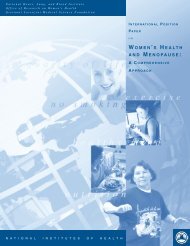HeartsNParks Community Mobilization Guide - National Heart, Lung ...
HeartsNParks Community Mobilization Guide - National Heart, Lung ...
HeartsNParks Community Mobilization Guide - National Heart, Lung ...
You also want an ePaper? Increase the reach of your titles
YUMPU automatically turns print PDFs into web optimized ePapers that Google loves.
cholesterol. Strive for less than 300<br />
milligrams of cholesterol a day. Dietary<br />
cholesterol is found only in foods that come<br />
from animals. And even if an animal food<br />
is low in saturated fat, it may be high in<br />
cholesterol; for instance, organ meats (like<br />
liver) and egg yolks are low in saturated fat<br />
but high in cholesterol. Egg whites and<br />
foods from plant sources do not have<br />
cholesterol.<br />
5 Choose foods lower in salt and sodium.<br />
Americans eat more salt (sodium chloride)<br />
and other forms of sodium than they need.<br />
Often, when people with high blood<br />
pressure cut back on salt and sodium, their<br />
blood pressure falls. Cutting back on salt<br />
and sodium also prevents blood pressure<br />
from rising. African Americans, the elderly,<br />
and persons with certain illnesses are more<br />
affected by sodium than others. Since<br />
there’s really no practical way to predict<br />
exactly who will be affected by sodium, it<br />
makes sense to limit intake of salt and<br />
sodium to help prevent high blood pressure.<br />
Americans, especially people with high<br />
blood pressure, should eat no more than<br />
about 6 grams of salt a day, which equals<br />
about 2,400 milligrams of sodium (the daily<br />
reference value you see on the new food<br />
label). That’s about 1 teaspoon of table salt.<br />
But remember to keep track of ALL salt<br />
eaten—including that in processed foods<br />
and added during cooking or at the table.<br />
30 Healthy Eating<br />
6 Maintain a healthy weight, and lose<br />
weight if you are overweight.<br />
People who are overweight tend to have<br />
higher blood cholesterol levels. And, as<br />
body weight increases, blood pressure<br />
increases. Overweight adults with an “apple<br />
shape— bigger (pot) belly—tend to have a<br />
higher risk for heart disease than those with<br />
a “pear” shape—bigger hips and thighs.<br />
Whatever your body shape, when you cut<br />
the fat in your diet, you cut down on the<br />
richest source of calories. However, even<br />
some low-fat foods are high in calories. So<br />
it is not only what you eat but how much<br />
you eat. An eating pattern of foods high in<br />
starch and fiber, instead of fat and calories,<br />
in moderation is a good way to help<br />
control weight.<br />
7 Be more physically active.<br />
Being physically active helps<br />
improve blood cholesterol levels.<br />
Being more active also can help<br />
you lose weight, lower your<br />
blood pressure, improve the<br />
fitness of your heart and<br />
blood vessels, and reduce<br />
stress. And being active<br />
together is great for the<br />
entire family.<br />
NHLBI Health Information Center<br />
P.O. Box 30105, Bethesda, MD 20824-0105<br />
phone: (301) 592-8573 fax: (301) 592-8563
















